#52 (tie): ‘News from Home’: The Reveal discusses all 100 of Sight & Sound’s Greatest Films of All Time
Chantal Akerman's epistolary 1976 documentary reflects on her time in New York City through lonely images and letters from her mother.
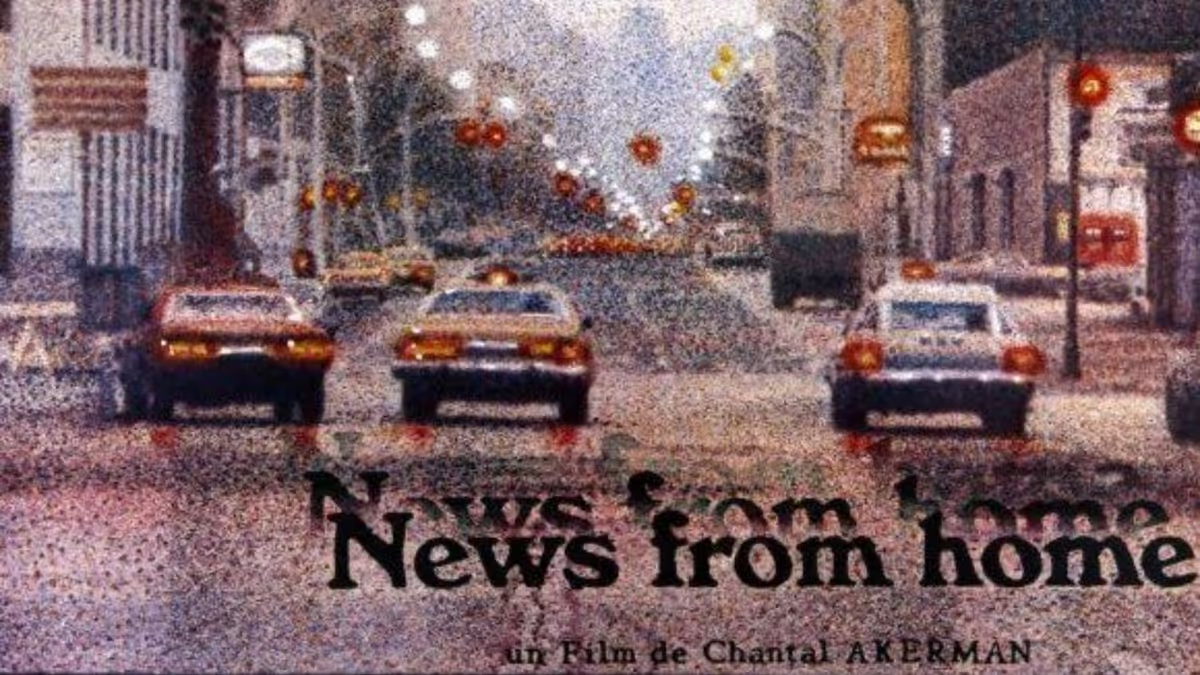
On December 1st, 2022, Sight & Sound magazine published “The Greatest Films of All Time,” a poll that’s been updated every 10 years since Bicycle Thieves topped the list in 1952. It is the closest thing movies have to a canon, with each edition reflecting the evolving taste of critics and changes in the culture at large. It’s also a nice checklist of essential cinema. Over the course of many weeks, months, and (likely) years, we’re running through the ranked list in reverse order and digging into the films as deep as we can. We hope you will take this journey with us.
News from Home (1976)
Dir. Chantal Akerman
Ranking: #52 (tie)
Previous ranking: N/A.
Premise: From 1971 to 1973, before she returned to her home in Brussels, Belgium to make 1975’s Jeanne Dielman, 23 quai de Commerce, 1080 Bruxelles—the film that Sight and Sound voters deemed the greatest of all time in the 2022 poll—Chantal Akerman moved to New York City, where she frequently received letters from her concerned mother, Natalia Akerman. Using footage that she and her cinematographers, Babette Mangolte and Jim Asbell, shot of the city in the summer of 1976, this avant-garde film sets those letters against a wordless NYC backdrop to create a unique epistolary documentary.
Scott: We’ll obviously be discussing this at the end of this project, Keith, when we get to Jeanne Dielman at #1, but one of the clear and dramatic changes to the 2022 poll from previous years was the rapid ascent of Belgian filmmaker Chantal Akerman in critical estimation. Jeanne Dielman shot up to #1 after ranking only #38 in the 2012 version, and News from Home, her follow-up, is now tied for #52 after having not appeared in any previous incarnation of the poll at all. Without speculating too much over how Akerman made such a leap, I would like to direct your attention to this tweet of mine—now imported to Bluesky—that proved to be quite prescient, specifically this part: “If I’m at the track, I’m betting the long odds on Jeanne Dielman pulling off a shocker.” I certainly sensed that Akerman’s stature among serious critics had been boosted over the years, not to mention her influence on other filmmakers of “slow cinema” school, and I was personally blown away by Jeanne Dielman, which is one of those films that make you rethink what movies can do. (It made the Top 10 I submitted.)
News from Home is the bigger surprise for me, which is not necessarily a comment on its virtues. While Jeanne Dielman had been given the full Criterion treatment, News from Home was tucked into an Eclipse box set entitled “Chantal Akerman in the Seventies,” which I reviewed back in 2010 for the A.V. Club. (I gave it a B+, putting slightly behind her estimable 1974 film Je Tu Il Elle, which struck me as a precursor to Stranger Than Paradise.) Yet the names of those who included News from Home on their Top 10 list is estimable—Dennis Lim, J. Hoberman, Nicolas Rapold, our friend Monica Castillo—and I feel like Akerman’s death from suicide in 2015, along with the film’s vivid snapshot of a long-passed New York City, have given the film a new and special resonance over time. It struck me as a deeply melancholy piece of work in ways that Akerman both intended at the time and could not have anticipated.
The Reveal is a reader-supported newsletter dedicated to bringing you great essays, reviews and conversation about movies. If you are not paid subscriber, we would love for you to click this button below and join our community.
The key word here being “time.” The experience you would have had with News from Home in 1975 isn’t the same as the one you have with it now, 50 years later. That New York is gone and Akerman is gone, too, and I feel like we’re mourning those losses now in a way that wasn’t possible then. Given that time is a primary theme in Akerman’s work, it would not surprise me if she anticipated that her documentary would change, just as other artists have designed, say, nature-based sculptures that are shaped by passing seasons and the tides. (I’m thinking of someone like Andy Goldsworthy, whose work was chronicled in the documentary Rivers and Tides: Andy Goldsworthy Working with Time.) A cruder version of this phenomenon would be those 8mm silent home movies that families like mine used to keep in the attic. So much of the fun and fascination of dragging those movies out was to see the fashions and settings that had long since gone away. (To me, the camcorders that replaced those 8mm movies with video and sound were a comparative bore, but that’s another discussion.)
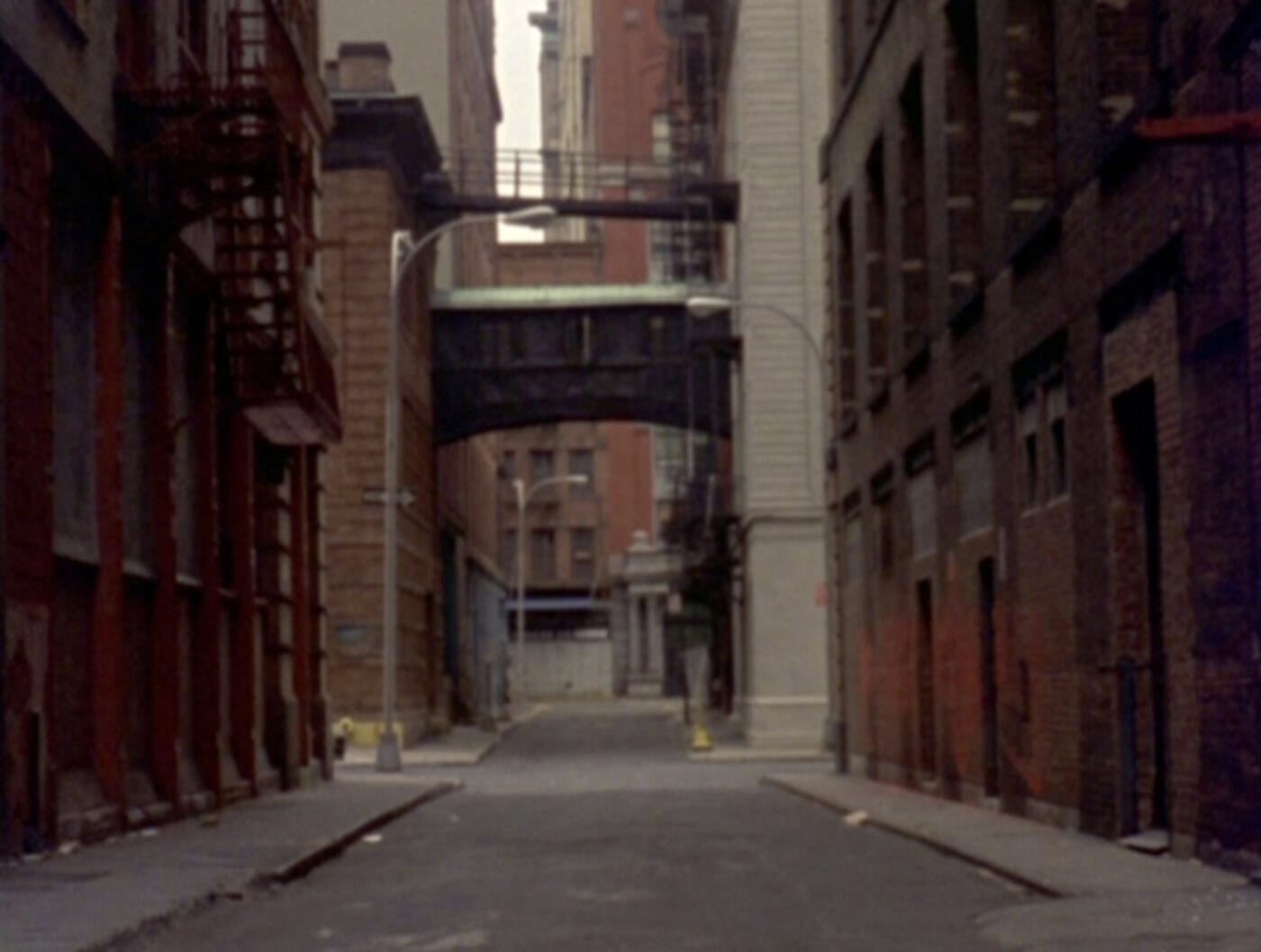
If you’re like me, Keith—and I believe, based on our many conversations about this, you are—you’re a sucker for any film loaded with New York exteriors that was produced in the ’70s and ’80s, before the city was “cleaned up” over the decades that followed. The grittier, the better, which for me meant a lot of horror movies like Maniac or Ms. 45 or Sisters or Basket Case. There’s nothing like a menace in News from Home, but Akerman’s focus on the streets, sidewalks, and subways in the city, rather than the people (at least people we hear), is absolutely mesmerizing to me. I’m reminded of Robert Kolker’s seminal 1980 book Cinema of Loneliness with Travis Bickle on the cover, because that image, along with the title, captured my imagination before I read a word of it. That sense of alienation is just so acute.
And I think you feel it with News from Home. There’s much to discuss here about the substance of Akerman’s mother’s letters, but I think it’s clear that she’s worried about her daughter and sad that she’s gone away to this faraway and dangerous city across the ocean. It seems from the context that Akerman left suddenly and for an indefinite period, which has upset both her parents and sets the tone for many of the letters. But what we don’t hear are Akerman’s own letters back to her mother, only the semi-frequent scolding that she doesn’t write enough of them. And so we have to rely on these images—which are of sections of the city that she frequented on her walks while she lived there—and wonder about the silent woman producing them. Do they speak to you in any way about her state of mind, Keith? What kind of feelings do these images evoke for you?
Keith: Before we get to the images I want to talk about the letters and the title. When not scolding her for not writing enough or expressing worry about her daughter’s well-being—which, admittedly, is a lot of what’s in the letters—Akerman’s mother offers bits of info about what’s going on in Brussels. The film makes it seem further and further away over the course of its running time. The more New York scenes we see, the harder it is to grasp whoever created these images existing anywhere else, even if they’re from elsewhere. The cadence slows over the course of New from Home. I even found myself startled a couple of times when the voiceover kicked in unexpectedly after one of the long, hypnotic passages without it. In other stretches, the noises of the city drown out the letters. Whatever the reality—and the reality is that Chantal and Natalia Akerman remained close up to Natalia’s death—the effect is of someone drifting further and further away from the voice behind those letters. The title News from Home starts to feel ironic. The very idea of “home” starts to lose meaning.
Scott, you and I have talked about what happens when a filmmaker from elsewhere makes a film in the United States and finds a perspective that a native filmmaker might not. (See Wim Wenders’ Paris, Texas, for instance.) I don’t think that’s entirely what’s going on here, however. The images of New York we see play like the work of someone who’s been absorbed by the city and isn’t sure what to make of the experience. New York isn’t a place of enchantment or of overwhelming dread. Akerman presents her New York images matter-of-factly, but with an artists’ eye for composition. Movie miracles come in all shapes and sizes. Here it’s the moment when the subway train stops at just the right moment to allow Akerman’s camera to capture the name of the stop so that it’s framed by the opening door.
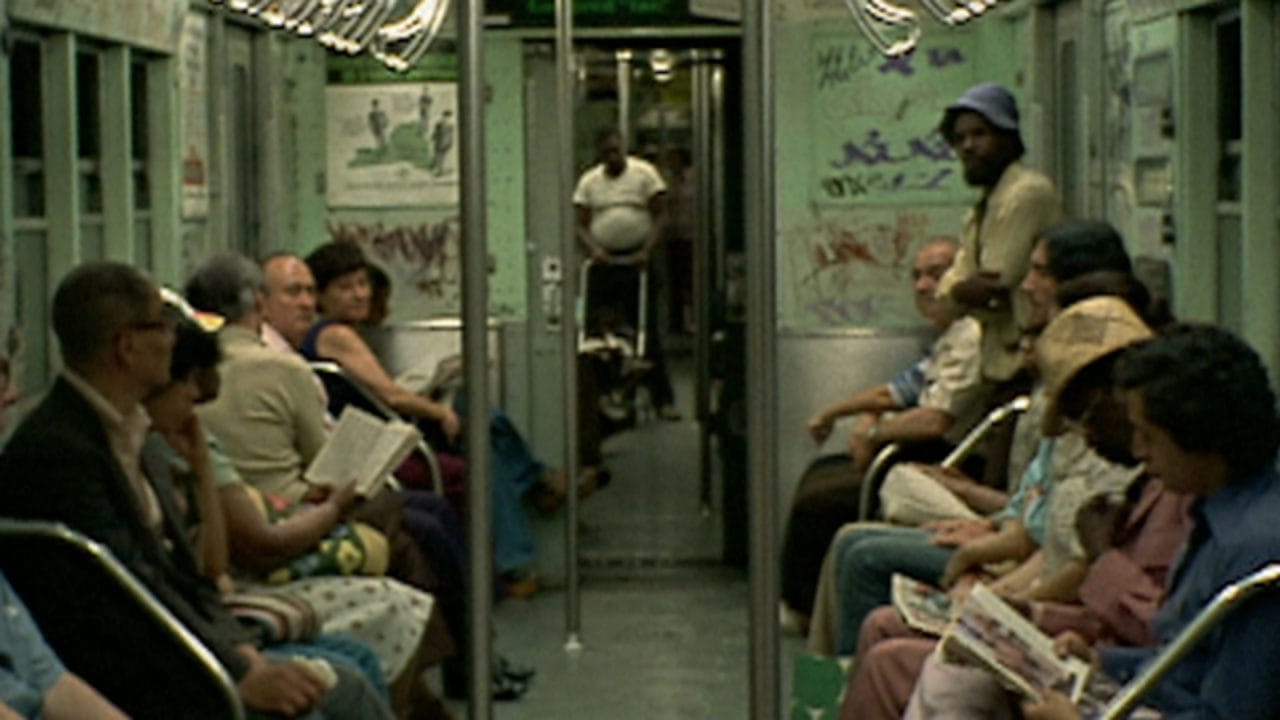
I can only talk about what these images look like now, not what they might have looked like in the ’70s. The time capsule qualities are startling, but I also think there’s a time machine quality to the film. Apart from a handful of portrait-like images, most of Akerman’s subjects seem oblivious to the camera. But in some shots, particularly one stretch on the subway, they seem to become aware of its presence and stare at it with a sense of suspicion. It’s almost as if Akerman’s a visitor not just from Belgium but from the future. These are ’70s people. It’s not like they don’t know what cameras are, but they’re not used to them being an everyday presence or of every moment potentially being immortalized in a recording. Why would anyone want to film a subway trip anyway?
In bare description, this movie sounds like, at best, an experimental curiosity yet it’s anything but that. This was my first time watching it and I found it unexpectedly overwhelming. Some of that was the result of the poignance of Natalia Akerman’s letters. “You never call, you never write,” are the words of every clichéd parent of an adult child, but the letters capture a mother who’s truly worried about her daughter’s safety and well-being and, without calls and letters, has no way of knowing what’s going on. (Admittedly, writing as often as she likes does seem pretty demanding.) But much of it has to do with the way Akerman shoots New York, even though I’m struggling to explain why I find this so moving. That this version of the city has effectively disappeared has something to do with that. (Akerman could have had no idea the added meaning the image of the World Trade Center would take on when she made News from Home.) But there’s a studied artistry to these images that I’m struggling to find ways to describe. So it’s here I throw back to you so you can do it. What is it about the way Akerman shoots the film that makes News from Home so remarkable?
Scott: I’m struck by the absence of that hustle-and-bustle you expect from “the city that never sleeps.” Akerman isn’t creating a survey of New York City, and while she is certainly keen to show how people look, she doesn’t care to hear what they have to say. She conceived News from Home in a rigorous fashion, transposing her mother’s letters over images of New York shot years after those letters were written. I think that last part is significant, because there might have been a scenario in which Akerman had been shooting footage for the film at the same time she was in the middle of this correspondence with her mother. Now it’s like a memory piece, with the letters triggering Akerman to evoke the parts of the city she experienced and perhaps try to express through these new images how she was feeling at the time.
I didn’t get a chance in my first missive to talk about the contents of the letters, so let me do that now. The impression I get is that Akerman’s decision to leave Brussels for an indefinite stay across the Atlantic was sudden and caused a great deal of distress for her family. An early passage, for example, reads “Father enjoys reading your letters. He hopes you’ll become famous. We’re not angry that you left without a word but do keep us informed.” It is not uncommon, of course, for a parent to worry about her child, especially when they’re so far away (and especially if they’re in the United States, which Natalia is not alone in presuming to be “dangerous.”). But there’s an anxious tone to these letters that’s unusual to me, connected to a genuine concern that Akerman may not be well-equipped to thrive, practically or perhaps mentally, in a foreign city like New York. What will she do for money? Does she have support? And what could possibly be happening to her in the days between her letters home? If you’re a worried parent, the imagination reels!
Other highlights from the letters: There’s one where Natalia writes about reading her daughter’s screenplay, which she considers “well-written” while also confessing it’s not to her taste because it’s “sad and gloomy.” I was touched, however, that she concludes by stating that “the public must be made aware of all this suffering that you young people see so clearly.” Of the many letters that must have triggered a lot of guilt for Akerman, the standout for me is one where Natalia writes about her father having a dream about her coming back and then leaving again, and how it left him shaken and depressed all day. (The follow-up is nice, though: “Sweetheart, if you only knew how proud your father is of you. If I had the money, I’d come see you, but I’d have to win the lottery first.”)
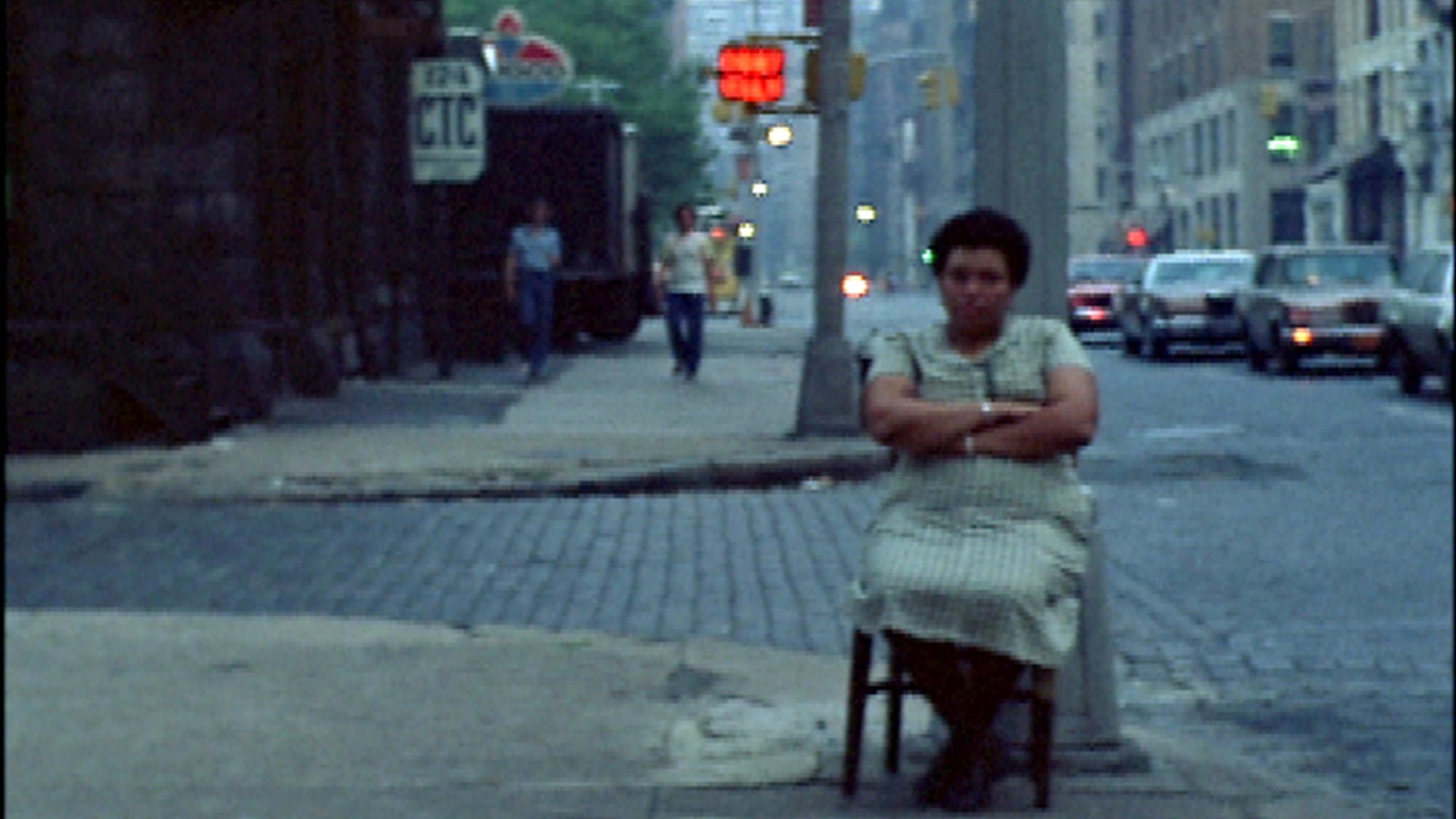
I second your observation about those long stretches, particularly in the final third, where we don’t hear much of anything from the letters and are just focused on Akerman’s portrait of New York. (Or when something like the subway noise just drowns out the narration entirely, which has the effect of yadda-yadda-yadda-ing letters that have a predictable drumbeat of motherly fretting.) The footage that Akerman is presenting in this film isn’t an answer to her mother’s letters per se—I imagine those were full of “Hey don’t worry, I’m fine” reassurances, but who knows—but they do see to reflect what she was seeing and how she was feeling in a very personal, highly subjective way. And while we do get shots of crowded subway cars and some rush-hour foot traffic, I still maintain that Akerman’s New York is conspicuously quiet and underpopulated.
To that end, News from Home feels so much to me like using New York exteriors to suggest an interior portrait, one that carries some of the profound alienation that defines a film like Jeanne Dielman. You’re right, Keith, that we do love to see movies about America from the perspective of non-Americans (e.g. Paris, Texas, Twentynine Palms, Midnight Cowboy, etc.), and I think Akerman shoots New York as a place that doesn’t feel like home. She finds lots of beauty in it—those early-hours shots of mostly empty streets, with only the occasional cab or shipping truck passing through, are so gorgeous—but you sense a distance, too, which I suppose is something the camera enforces. There’s a barrier between Akerman and the world that she’s observing.
And how about those final shots, Keith? The camera appears to be aboard a ferry or other boat that’s drifting away from Lower Manhattan, which of course gives us that haunting, fog-shrouded final view of the World Trade Center towers. The soundtrack really focuses on the lapping of the water against the ship, which allows for this mesmeric treatment of a city that appears almost as it would in a snowglobe—if, you know, you had no intention of selling such a snowglobe to tourists. Akerman would return to New York and make a home there, including a final stint as a faculty member for the MFA program at City College. But News from Home, to me, feels like the film of a visitor who hasn’t found her way yet. What do you think, Keith?
Keith: In his blurb for the Chicago Reader, Jonathan Rosenbaum calls it “one of the best depictions of the alienation of exile that I know.” I find myself agreeing with that sentiment while wishing Rosenbaum had expanded on it because I’m having trouble putting the feelings it evokes into words. J. Hoberman comes closer in a 2016 appreciation for Artforum when he writes:
The absent mother and the present daughter are represented by stand-ins. The filmmaker is distanced from the anxious litany of family events, while the letters emphasize her own foreignness. [...] As the film progresses, New York prevails over Brussels. The frequency of the letters decrease; the individual shots grow longer. As concrete and immediate as it is, Akerman’s movie evokes a powerful sense of separation (not only between here and there but between sound and image, as well as child and parent).
I think that comes close to capturing why this film works, but it’s certainly not easy to put that into words. It’s worth remembering that for as much of News from Home presents long shots of New York as Akerman and her collaborators found it, a lot of choices have gone into making the final film. There is, of course, the matter of what images to include, where to place them, and which letters should accompany which shots.
But, beyond this, Akerman created the soundtrack, which only sounds like the live, ambient noises of the scene it accompanies if you don’t listen too closely. The sounds of the train accelerating and decelerating matches what we see, but the absence of discernible chatter gives the film a kind of haunted feeling. Even when Akerman depicts crowds, the film feels hollowed-out and lonely. Akerman’s cutting room floor might have been lined with images of bustling, happy New Yorkers but that’s not what Akerman shows us because that’s not the experience she wanted to share.
Phew! That was a lot of 1970s urban alienation as experienced by outsiders from elsewhere. Surely our next film will move onto other themes. Let’s see what it is…. OK, it’s Rainer Werner Fassbinder’s Fear Eats the Soul. Hmm…
Previously:
#95 (tie): Get Out
#95 (tie): The General
#95 (tie): Black Girl
#95 (tie): Tropical Malady
#95 (tie): Once Upon a Time in the West
#95 (tie): A Man Escaped
#90 (tie): Yi Yi
#90 (tie): Ugetsu
#90 (tie): The Earrings of Madame De…
#90 (tie): Parasite
#90 (tie): The Leopard
#88 (tie): The Shining
#88 (tie): Chungking Express
#85 (tie): Pierrot le Fou
#85 (tie): Blue Velvet
#85 (tie): The Spirit of the Beehive
#78 (tie): Histoire(s) du Cinéma
#78 (tie): A Matter of Life and Death
#78 (tie): Celine and Julie Go Boating
#78 (tie): Modern Times
#78 (tie): A Brighter Summer Day
#78 (tie): Sunset Boulevard
#78 (tie): Sátántangó
#75 (tie): Imitation of Life
#75 (tie): Spirited Away
#75 (tie): Sansho the Bailiff
#72 (tie): L’Avventura
#72 (tie): My Neighbor Totoro
#72 (tie): Journey to Italy
#67 (tie): Andrei Rublev
#67 (tie): The Gleaners and I
#67 (tie): The Red Shoes
#67 (tie): Metropolis
#67 (tie): La Jetée
#66: Touki Bouki
#63 (tie): The Third Man
#63 (tie): Goodfellas
#63 (tie): Casablanca
#60 (tie): Moonlight
#60 (tie): La Dolce Vita
#60 (tie): Daughters of the Dust
#59: Sans Soleil
#54 (tie): The Apartment
#54 (tie): Battleship Potemkin
#54 (tie): Blade Runner
#54 (tie): Sherlock Jr.
#52 (tie): Contempt
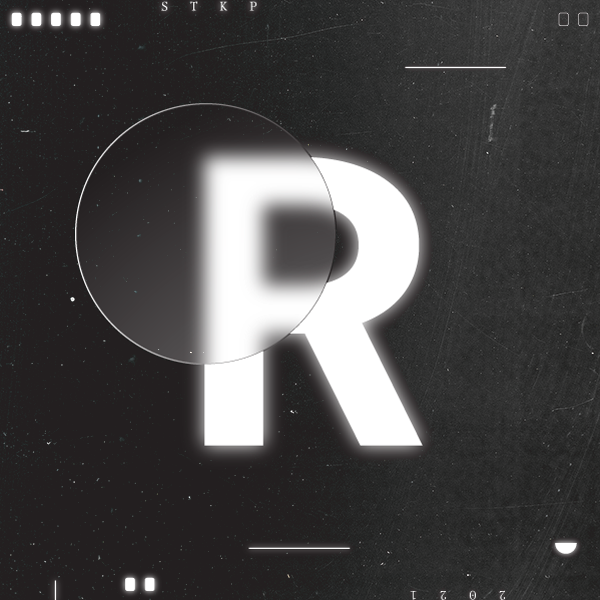
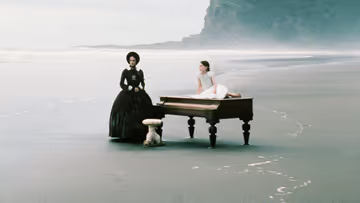
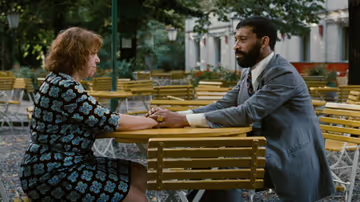

Discussion